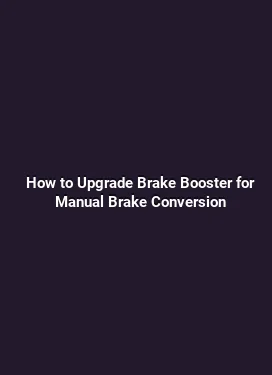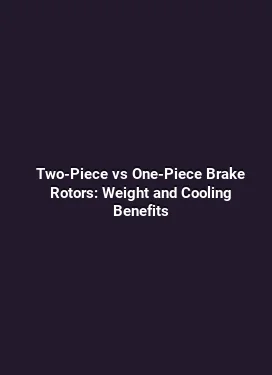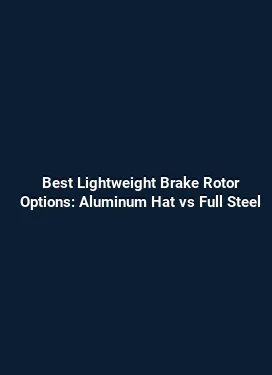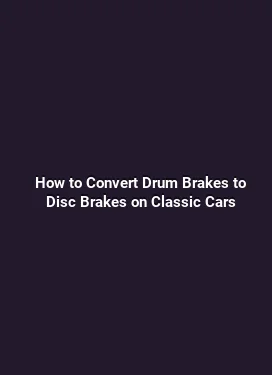How to Install Big Brake Kit on Honda Civic without Wheel Clearance Issues
Understanding Big Brake Kits and Wheel Clearance

Upgrading to a big brake kit (BBK) is a common path for Civic owners seeking improved stopping performance, stronger pedal feel, and more consistent fade resistance during spirited driving. A BBK typically includes larger rotors, multi-piston calipers, beefier brake pads, and upgraded hardware. While the performance benefits are appealing, the most critical constraint during a retrofit is wheel clearance. The broad diameter of rotors and the extended caliper bodies can interfere with wheel spokes, inner wheel lips, or even the caliper mount points themselves. A successful installation begins with clarifying what you actually need in terms of rotor diameter, caliper width, and hub compatibility, and then aligning those choices with your current wheels and suspension geometry. A well-planned approach emphasizes compatibility between the BBK components and the Civic’s design. It is not only about the largest possible rotor but about an integrated package that maintains proper pad-to-rotor alignment, brake line routing, and pedal feel. Balancing performance targets with wheel clearance requirements reduces the risk of rubbing, heat transfer to wheel wells, and unintended contact with fasteners or fenders under load and steering input.
Key factors that influence clearance

Rotor diameter, rotor thickness, caliper width, hub spacing, and rotor hat design all determine whether the wheel can sit without interference. Even identical-looking aftermarket rotors can have subtle differences in offset that affect fitment. Caliper mounting points need to be evaluated for potential contact with wheel spokes or the inner lip of the rim. Additionally, the wheel offset (ET value) and width influence clearance, particularly when upgrading to a larger rotor with a more aggressive caliper. A thorough assessment includes measuring existing wheel inner clearance, evaluating tire sidewall bulge under load, and confirming that brake hardware does not protrude into contact areas when the suspension compresses during cornering or braking.
Assessing Your Honda Civic's Baseline Clearance
Before selecting a BBK, establish a clear baseline of your Civic’s existing clearance. This involves both static measurements and dynamic considerations. Start with the front wheels: with the car on a flat surface and the steering centered, rotate the wheels from lock to lock and inspect any potential contact between the caliper bodies and the wheel inner surface. Measure the maximum space between the caliper face and the wheel bead seat. Repeat the process with the suspension compressed (jounce test) to simulate rough road conditions. These measurements create a clearance envelope that your BBK must fit within. Do not assume that a larger rotor will automatically be compatible; sometimes the raw diameter alone can introduce unexpected interference when paired with certain wheel designs or tire profiles.
Tools and methods for accurate measurement
Accurate measurement requires a combination of calipers, a tape measure, and a depth gauge. Document rotor diameter, caliper width, and the space between the caliper and wheel spokes. A mock-up approach using cardboard cutouts of the proposed rotor and caliper can help visualize interference points before ordering parts. It is also prudent to check hub center bore compatibility, as a mismatch can affect wheel mounting accuracy and create vibration or runout issues at speed.
Selecting the Right Caliper and Rotor Combination
Choosing components that naturally fit the Civic’s geometry reduces the risk of clearance problems. Options range from bolt-on calipers designed for the Civic’s stock knuckle spacing to modular kits that adapt radius or caliper mounting points. When evaluating rotor size, consider both the outer diameter and the rotor hat height. A rotor with a larger outer diameter but a recessed hat or a different hat offset might clear the wheel where another rotor would not. Some enthusiasts opt for a two-piece rotor solution with a lightweight hat to lower rotating mass while preserving the required braking surface. Caliper choice should prioritize compact, multi-piston designs that align with the Civic’s wheel wells and fender geometry without encroaching on the inner wheel area during steering and compression. Compatibility checks should include: mounting hole pattern alignment, caliper piston count and width, brake line routing length, and the possibility of needing new hardware such as braided lines or banjo bolts. Real-world fitment testing with the actual wheels planned for use is invaluable to confirm clearance across steering angles and suspension travel.
Common configurations for Honda Civic models
Depending on the generation, common BBK configurations for the Civic include 12- to 14-inch rotor upgrades with multi-piston calipers. Some kits use floating or fixed calipers, while others rely on a four- or six-piston design, each with distinct thickness and offset profiles. The goal is to maximize clamping force without increasing the likelihood of wheel contact. For street-driven Civics, a balance between performance and daily drivability is essential, so many builders lean toward slightly oversized discs paired with compact calipers rather than extreme rotor diameters that necessitate wheel spacers or aftermarket wheels with unique offsets.
Brake Line and ABS Considerations
Upgrading to a bigger brake kit often requires re-routing or lengthening brake lines. The Civic’s brake lines must accommodate the increased rotor travel and potential caliper geometry changes. Ensure the line routing remains free of heat sources, sharp edges, or moving components under suspension articulation. For ABS-equipped models, verify that the ABS tone rings, wheel speed sensors, and wiring remain compatible with the new caliper placement and rotor diameter. Some BBK packages include updated ABS sensor carriers or adapters to maintain proper signal timing and wheel speed data, which is critical for stability control and anti-lock performance during heavy braking. When in doubt, consult the kit’s documentation for compatibility notes and ensure the installation preserves factory safety features.
Brake fluid and pedal feel considerations
A larger brake system can alter pedal travel and feel due to changed hydraulic volume and system pressure. Plan for a compatible brake fluid type and bleed procedure to remove air from the longer or repositioned lines. Upgrading to a higher-capacity master cylinder is not always required, but some builds benefit from a slight change in hydraulic ratio to maintain a firm, linear pedal feel. When testing pedal responsiveness during bed-in, monitor for sponginess or inconsistent braking pressure that could indicate air pockets or micro-leaks in the system.
Wheel Fitment and Spacing Solutions
Wheel clearance is a nuanced puzzle involving wheel width, offset (ET), tire profile, rotor and caliper geometry, and suspension travel. A successful BBK installation without wheel clearance issues often involves one or more of the following strategies. First, selecting wheels with a slightly different offset or a narrower mounting surface can create additional space between the caliper and the wheel barrel. Second, choosing a rotor with a recessed hat design or a different hub-centric diameter can reduce the chance of contact with the wheel’s inner surface. Third, adjusting the brake line routing and choosing compact caliper bodies helps preserve usable space inside the wheel well. In some cases, spacers are considered, but this approach can adversely affect steering feel and suspension geometry. The most reliable path is selecting a wheel and BBK combination that are proven to coexist without clearance conflicts under typical daily driving and aggressive braking scenarios.
Practical fitment checks during the build
During the final fitment phase, install the wheels with the tire partially inflated to seated height and rotate through full steering lock-to-lock while someone observes from the wheel wells. Look for rubbing at the inner fender liner, caliper ears, or rotor hat. If rubbing occurs, document the exact location and repeat with different steering angles or suspension travel states. If spacers become necessary, prefer hub-centric spacers with appropriate torque specs and ensure they do not create leverage that could loosen fasteners over time. It is also crucial to verify that wheel lug studs engage fully with the wheel and that there is no contact with the caliper mounting bolts or bracketry under load.
Installation Steps with Practical Tips
Installing a BBK is a multi-step process that benefits from a structured approach. Begin with a clean workspace, labeled hardware, and a comprehensive parts checklist. Remove the wheels, inspect the caliper mounting area for corrosion or damaged threads, and ensure the caliper mounting points are true. The rotor removal process should be performed with the vehicle supported securely and the rotor fasteners undisturbed. When mounting the new rotor, confirm that the orientation is correct and that the rotor is free of protective coatings at the contact area where the brake pads will engage. Caliper installation involves aligning the caliper pins with the mounting bracket and torqueing to the manufacturer’s specification. Brake pads must be installed in the correct orientation and re-checked after the system is bled and tested for the first time.
Bleeding, bedding-in, and initial testing
After assembly, bleed the brake system to remove air pockets and ensure consistent pedal feel. Use a proper grade of brake fluid and bleed in the recommended sequence for each corner. The bed-in procedure typically involves controlled, repeated stops from moderate speeds to transfer a uniform layer of pad material onto the rotor surface. This process reduces glazing and ensures peak performance. During initial testing, monitor for unusual noises, vibration, or pedal travel anomalies. Gentle, progressive braking in the first minutes of operation helps the system settle and reduces the risk of rotor glaze or pad glazing.
Maintenance and Long-Term Considerations
BBKs require periodic inspection just like stock brakes, with special attention to caliper pistons, guide pins, and rotor wear. Keep an eye on pad depth and rotor smoothness; any pulsation or uneven wear can indicate misalignment or caliper sticking. Use high-quality lubrication on caliper pins and inspect torque on mounting bolts at recommended service intervals. If you plan track days or aggressive driving, schedule more frequent inspections for heat-related wear and check for potential rotor warping. A well-documented maintenance routine helps sustain performance and preserves wheel clearance by preventing unexpected caliper or rotor shifts due to wear or looseness.
Real-world tips for consistent results
Document measurements before and after a BBK installation, including rotor thickness, caliper width, and wheel clearance. Keep a log of wheel and tire combinations tested with the kit, noting any clearance issues or improvements in braking performance. When selecting pads, consider compounds that are compatible with high-temperature operation while maintaining low dust output and good pedal feel. Regularly inspect brake lines for signs of abrasion or cracking, particularly where lines bend near the wheel well or suspension components. Finally, choose a reputable installer or consult a professional with BBK experience for a second opinion during the initial setup and after any modifications to steering or suspension geometry.
Troubleshooting Common Pitfalls
Clearance problems often stem from mismatched wheel offsets, rotor hats that extend beyond the hub flange, or caliper bodies that collide with wheel spokes. The most common corrective action is selecting wheels with a more favorable offset or opting for a rotor with a shallower hat height. Another frequent issue is insufficient brake line length after a caliper swap, which causes routing tension or excessive flexing. If ABs signals are inconsistent, verify sensor alignment and harness routing to prevent interference with wheel rotation. A proactive approach combines careful part selection with thorough pre-install measurements and a staged test plan to ensure reliability before pushing the Civic into higher-performance driving scenarios.
Case Studies and Practical Scenarios
Consider a Civic sedan from a late-generation platform that uses a 12.9-inch rotor stock. Upgrading to a 13.5-inch rotor with a compact 4-piston caliper might maintain adequate space with a 17-inch wheel if offset is favorable. For owners running 18-inch or larger wheels, a 14-inch rotor could be excessive unless the caliper and wheel combination has proven compatibility. In another scenario, a two-piece rotor with a lightweight hat reduces rotational inertia, which can improve acceleration response and pedal feel while preserving the necessary clamping force. Each scenario emphasizes the importance of verifying actual clearance in both static and dynamic conditions rather than relying solely on nominal dimensions.
Conclusion-Alternative Pathways for Performance and Clarity
Achieving reliable wheel clearance while upgrading to a high-performance brake system on a Honda Civic is a process of careful component selection, precise measurement, and methodical fitment testing. By understanding the interplay between rotor diameter, caliper width, hub spacing, and wheel offset, contributors can craft a braking package that delivers measurable performance gains without compromising safety or daily drivability. The result is a Civic that stops confidently under load while maintaining dependable wheel clearance through a thoughtful, data-driven installation approach.






